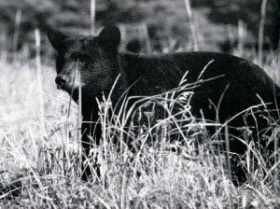JULY/AUGUST 2001
Vol. 18 No. 4
pages 93-192
Carnivore
Conservation in the Twenty-first Century
- by Nina Fascione and M.Elsbeth McPhee
I. Theory and Methods in Carnivore Conservation
Who
Limits Whom: Predators or Prey?
A
New Approach to Understanding Canid Populations Using an
Individual-Based Computer Model: Preliminary Results
- by William C. Pitt, Frederick F. Knowlton, and Paul W. Box
II. Carnivores and Habitat
Mapping
Occupied Habitat for Forest Carnivores in the American West and Estimating
their Conservation Status
Road
Density as a Factor in Habitat Selection by Wolves and Other Carnivores
in the Great Lakes Region
- by Adrian P. Wydeven, David J. Mladenoff, Theodore A. Sickley,
Bruce E. Kohn,
R. P. Thiel, and Jennifer L. Hansen
A
Predator-Habitat Assessment for Felids in the Inland Atlantic Forest
of Eastern Paraguay: A Preliminary Analysis
- by Gerald L. Zuercher, Philip S. Gipson, and Kim Hill
III. Raptor Conservation
Status
of the California Condor and Mortality Factors Affecting Recovery
- by Kelly J. Sorenson, L. Joseph Burnett, and James R. Davis
Raptors
as Vermin: A History of Human Attitudes towards
Pennsylvania's Birds of Prey

Mexican Wolf ( Canis lupus baileyi).
Photograph by B. Moose Peterson/WRP
IV. Felid Conservation
Status
and Conservation of Endangered Cats along the U.S.-Mexico Border
- by Melissa Grigione, Arturo Caso, Rurik List, and Carlos Lopez-Gonzalez
Molecular
Scatology as a Conservation Tool
Linking Snow Leopard Conservation and People-Wildlife Conflict Resolution:
Grassroots Measures to Protect the Endangered Snow Leopard from Herder
Retribution
- by Rodney Jackson and Rinchen Wangehuk
|

Black Bear ( Ursus americanus).
Photograph by B. Moose Peterson/WRP
Entire
Journal (acrobat file)

SUBSCRIBE
TO GET FULL ARTICLES
V. Canid Conservation
The
Status of the Wolf Population in Post-Soviet Kyrgyzstan
Gray
wolf restoration in the Northwestern United States
- by Ed Bangs, Joe Fontain, Mike Jimenez, Tom Meier, Carter Niemeyer,
Doug Smith, Kerry Murphy, Deb Guernsey, Larry Handegard, Mark Collinge,
Rod Krischke, John Shivik, Curt Mack, Issac Babcock, Val Asher, and
Dominic Domenici
The
Feasibility of Gray Wolf Reintroduction to the Grand Canyon Ecoregion
Canis
Soupus: Eastern Wolf Genetics and its Implications for Wolf Recovery
in the Northeast United States
- by Nina Fascione, Lisa G. L. Osborn, Stephen R. Kendrot, and Paul
C. Paquet
Captivity,
Inbreeding, Cross-Lineage Matings, and Body Size in
Mexican Wolves
- by Richard Fredrickson and Philip Hedrick
First
Swift fox, Vulpes velox, Reintroduction in the USA:
Results of the First Two Years
- by Clio Smeeton and Ken Weagle
Interspecific
Interactions Among Wild Canids: Implications for the Conservation of
Endangered San Joaquin Kit Foxes
- by Brian L. Cypher, Howard O. Clark, Jr., Patrick A. Kelly, Christine
Van Horn Job, Gregory D. Warrick, and Daniel F. Williams
VI. Predation Management
Chemical
Repellents and Other Aversive Strategies in Predation Management
- by J.R. Mason, J.A. Shivik, and M.W. Fall
Effectiveness
of Livestock Guarding Animals for Reducing Predation on Livestock
VII. Opinions
Historic
Attitudes and Images and the Implications on Carnivore Survival
Bringing
Down the Walls
News
from Zoos
|
